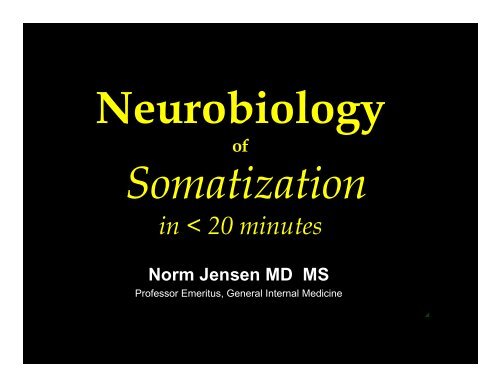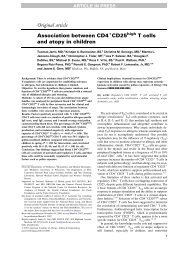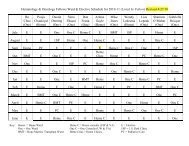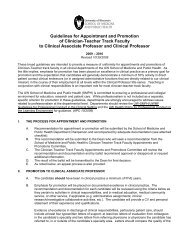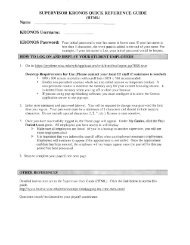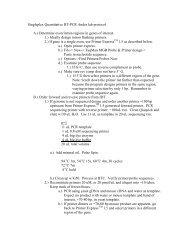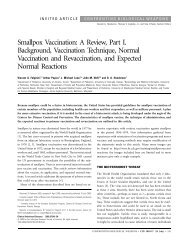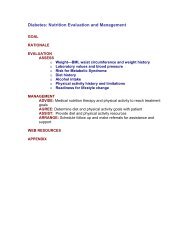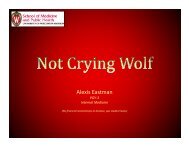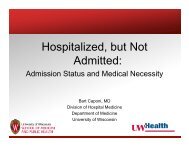Neurobiology of Somatization
Neurobiology of Somatization
Neurobiology of Somatization
Create successful ePaper yourself
Turn your PDF publications into a flip-book with our unique Google optimized e-Paper software.
<strong>Neurobiology</strong><br />
<strong>of</strong><br />
<strong>Somatization</strong><br />
in < 20 minutes<br />
Norm Jensen MD MS<br />
Pr<strong>of</strong>essor Emeritus, General Internal Medicine
Learning Objectives<br />
• Cognitive<br />
– New DSM V classification<br />
– <strong>Neurobiology</strong> <strong>of</strong> somatization<br />
• Attitudinal<br />
– ↑ interest & awareness<br />
– ↑ compassion
QUIZ: Who had more pain?<br />
A<br />
A<br />
B
<strong>Somatization</strong>, a definition<br />
• a tendency to experience and communicate<br />
somatic distress in response to<br />
psychosocial stress<br />
• indirect, unconscious, unintentional<br />
• subjective reality<br />
• pathophysiology evolving<br />
• 1960s = Briquette's syndrome<br />
• 1980s first in DSM III<br />
• 2013 new classification DSM V
“By golly, you ARE crying on the inside!”
ALERT: DSM-5 release expected May 18-22, 2013:<br />
at APA’s 2013 Annual Meeting in San Francisco, CA.<br />
• DSM IV<br />
• <strong>Somatization</strong> Disorder<br />
• Undifferentiated<br />
Somat<strong>of</strong>orm disorder<br />
• Somat<strong>of</strong>orm disorder, NOS<br />
• Hypochondriasis<br />
• Pain disorders<br />
• DSM V<br />
• Somatic Symptom Disorder<br />
• Illness Anxiety Disorder
DSM V Somatic Symptom Disorder<br />
• A. Somatic sx: 1 or more, distressing, &<br />
disrupting <strong>of</strong> daily life.<br />
• B. XS thoughts, feelings, behaviors with at least<br />
one <strong>of</strong> the following<br />
– Disproportionate & persistent thoughts <strong>of</strong><br />
seriousness<br />
– Persistent high related anxiety<br />
– Excessive time & energy devoted<br />
• C. Chronicity > 6 months<br />
• D. Severity<br />
– Mild = one “B” criteria<br />
– Moderate = two or more “B” criteria<br />
– Severe = “moderate” + multiple somatic sx
DSM V Somatic Symptom Disorder<br />
• Incorporates<br />
– Somat<strong>of</strong>orm disorders, all<br />
– Hypochondriasis, symptom predominant<br />
• ~ 75% <strong>of</strong> hypochondriasis cases<br />
– Pain disorders<br />
• Rationale<br />
– ↓ emphasis on the somatic symptoms<br />
– ↑ emphasis on the psychomotor response
DSM V Illness Anxiety Disorder<br />
• A. Somatic sx are absent or mild<br />
• B. Preoccupation with having or acquiring a<br />
serious illness<br />
– If risk factors present, preoccupation is<br />
disproportionate or excessive<br />
• C. High anxiety and low threshold for<br />
becoming alarmed about health<br />
• D. Excessive or maladaptive health behavior<br />
• E. > 6 months, persistent or intermittent<br />
• Variation: Acute somatization in depression<br />
• F. Not explained by other DSM disorder<br />
• SUBTYPES: Care seeking & Care avoiding
DSM V Illness Anxiety Disorder<br />
• Incorporates hypochondriasis with<br />
absent or mild somatic symptoms<br />
– ~ 25% <strong>of</strong> hypochondriasis
Suffering in somat<strong>of</strong>orm illness<br />
•Disease<br />
•Sickness<br />
•Illness
Theoretical Mechanisms:<br />
Social-psychological<br />
• Psychodynamic<br />
• defense mechanism<br />
• resolves conflict<br />
• Social learning<br />
• “big kids don’t cry”<br />
• warrior training<br />
• sick role - 1° gain<br />
Pilowsky I. Abnormal illness behavior. Brit J Med Psychol 1969;42:347-351.
Harrison’s<br />
Textbook<br />
1962 (4th Edition)<br />
Afferents only
Theoretical Mechanisms: Neurobiologic<br />
• Variable CNS modulation <strong>of</strong><br />
incoming sensory information, e.g.,<br />
– conversion = excessive inhibition<br />
– somatization = inadequate inhibition.<br />
• Melzack R & Wall P. Pain mechanisms: A new theory.<br />
Science. 1965;150:971-979<br />
• Wall P. The gate control theory <strong>of</strong> pain mechanisms: a reexamination<br />
and re-statement. Brain. 1978;101:1-18.
Central<br />
Control<br />
Attention, emotion,<br />
memory<br />
L<br />
Large fibers<br />
s<br />
+<br />
SGS G<br />
-<br />
-<br />
-<br />
+<br />
St→T<br />
+<br />
Action<br />
System<br />
Small fibers<br />
Gate Control System - Melzack & Wall, Science 1965<br />
SG = Substantia Gelatinosa (dorsal horn).<br />
St = spino-thalamic track. T = thalamus
Frontal<br />
Cortex<br />
Modulation<br />
Harrison’s Textbook 1983 (10 th ) Harrison’s Textbook 1994 (13 th )
PFC<br />
Cingulate & insula<br />
Somatosensory<br />
+ affect<br />
modulating<br />
cortex<br />
Efferent<br />
modulation<br />
2011, 18 th Ed. Harrison
Theoretical Mechanisms:<br />
A new Biopsychosocial Model<br />
A developmental theory<br />
•<strong>Somatization</strong> is not a disorder,<br />
but a developmentally<br />
appropriate response to stress in<br />
infants which normally<br />
diminishes with age as more<br />
mature capacities for distress and<br />
affect regulation are developed.<br />
• Landa A, Psychosom Med 2012;74:717
Theoretical Mechanisms:<br />
Biopsychosocial (Landa)<br />
• Negative early inter-personal<br />
experiences with caregivers may interact<br />
with genetic predisposition, leading to<br />
disrupted neural circuits involved in<br />
affect regulation and interpersonal<br />
functioning,<br />
• yielding the persistence into adulthood<br />
<strong>of</strong> developmentally earlier tendencies to<br />
experience distress somatically.
Landa A, et.al.<br />
Somat<strong>of</strong>orm<br />
Pain: A<br />
Developmental<br />
Theory and<br />
Translational<br />
Research<br />
Review<br />
Psychosomatic<br />
Medicine<br />
74:717Y727<br />
(2012)
Theoretical mechanisms<br />
Why rejection hurts: a common neural<br />
alarm system for physical and social pain.<br />
Eisenberger NI, Lieberman MD. Trends Cognitive Science 2004;8:294-300.<br />
• The loss <strong>of</strong> social bonds is one <strong>of</strong> the<br />
most painful experiences known to<br />
humankind.<br />
• Somatic injury words describe social<br />
losses, e.g, “broken heart”, “hurt<br />
feelings”.<br />
• Common to many world languages.
Anterior Cingulate Cortex (ACC) activates when<br />
viewing video <strong>of</strong> human exclusion similar to the<br />
experience <strong>of</strong> experimentally induced somatic pain.<br />
Eisenberger NI, Psychosomatic Medicine 2012;74:126-135<br />
fMRI ACC
Evidence for overlap<br />
•Surgical cingulotomy effectively<br />
treats intractable chronic pain.<br />
•Still feel the pain but it no longer<br />
bothers them<br />
–Highlights role <strong>of</strong> ACC in the<br />
distressing rather than the sensory<br />
component <strong>of</strong> somatic pain<br />
•Also less sensitive to social pain
Evidence for overlap<br />
•Opioids reduce social pain<br />
–1978 pr<strong>of</strong>oundly reduced crying<br />
and motor agitation <strong>of</strong> puppy dogs<br />
subjected to social isolation<br />
–1988 same in rhesus monkeys<br />
•neuro-endocrine also blocked<br />
•naloxone blocked both<br />
– implicating the opioid receptor
Evidence for pain modulation<br />
• Right ventral pre-frontal cortex is reciprocally<br />
activated in social and somatic pain and may act<br />
to down-regulate the distress <strong>of</strong> physical and<br />
social pain.<br />
• Rx?<br />
•mindfulness<br />
training<br />
Social pain<br />
Physical pain
IPV as neuro-disruption<br />
• Prevalance: 29% ♀ & 23% ♂<br />
• ♀ = ↑ physical, sexual, power & control IPV<br />
• ♂ = ↑ verbal and psychological IPV<br />
• ↑ likelihood <strong>of</strong> current poor health, depression, substance<br />
use, chronic disease, mental illness and injury<br />
– RR up to 2.6 X controls<br />
• In multivariate analysis, psychological abuse =<br />
strongest association with adverse health outcomes.<br />
• Am J Prev Med 2002;23:260<br />
• Violence and Victims 2007;22:437<br />
• JAMA 2009;302:437
Patient Centered<br />
Care, a pilot RCT<br />
• Patient-Centered<br />
Interviewing is<br />
Associated with<br />
Decreased<br />
Responses to<br />
Painful Stimuli.<br />
• An Initial fMRI<br />
Study. 2013, In<br />
Press.
↓ Pain Response in anterior Insula following P-C Interview<br />
RCT:<br />
Patientcentered<br />
Interview<br />
p = .16<br />
p = .05<br />
Photo <strong>of</strong> unknown physician<br />
Photo <strong>of</strong> interviewer
QUIZ: Who had more pain?<br />
A<br />
A<br />
B
Summary<br />
Suffering, disability and $<br />
↑ Bio-psycho-social plausibility<br />
Warrants stronger clinical<br />
Confidence & compassion<br />
Team care planning<br />
Continued learning
The abstract ends here!<br />
Questions?<br />
Answers $0.25<br />
Answers requiring thought $1.00<br />
Correct answers $2.50<br />
Comments?
Diffusion tensor imaging<br />
Fibers<br />
oriented<br />
left–right =<br />
red,<br />
anterior–<br />
posterior =<br />
green,<br />
superior–<br />
inferior =<br />
blue.
Proc Natl Acad Sci U S A. 2003;100:8538


